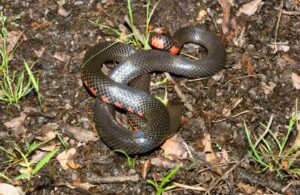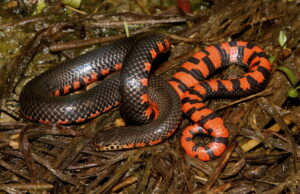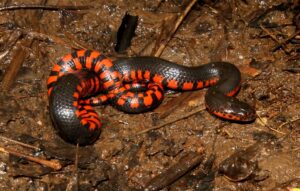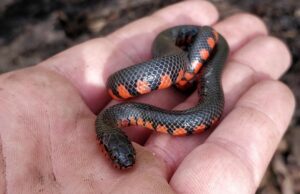Western Mud Snake (Farancia abacura reinwardtii)
Updated on
25/04/2024The western mud snake is a subspecies of the mud snake. It is a shiny, iridescent, medium-sized, semi-aquatic colubrid that is at home in the water but moves over land between water bodies. It is also known as the hoop snake for its tendency to lie in a circular coil. Another common name is the horned snake, attributed to the sharp and hardened horn-like end point of its tail.
Scientific Classifications
- Suborder:Serpentes
- Family:Colubridae
- Genus:Farancia
- Species:F. abacura
- Subspecies:F. a. reinwardtii
Conservation Status
Description
Size
The total length attained by the snake is 40-54 in (1-1.4 m). Some specimens have been found measuring as long as 81.5 in (2 m).
Color and Appearance
The western mud snake is glossy and iridescent black on its dorsal side. The belly is pink, red, and orange with some black banding and spots. The tail has a crossband pattern on the ventral side. The scales are smooth except in the anal region, where they are keeled. The anal plate is usually divided but may be undivided in some individuals.
Are They Dangerous to Humans
They rarely bite when handled. But they tend to press the pointed end of their tail into the flesh of the captor. But it cannot break human skin and is completely harmless.
Western Mud Snakes at a Glance
Distribution
They live in the southern US, from Virginia to Florida, north into the lower Mississippi River Valley, and west to Texas.
Habitat
The subspecies live in and near big natural cypress swamps, taking shelter in animal burrows and under logs. It also lives in slow-moving bodies of water and wet lowlands. The serpent prefers shallow places with an abundance of water-soaked or rotten logs.
The nocturnal snake can be seen basking in the early morning sun after coming out of burrows made in muddy banks.
Lifespan
It lives for around 19 years.
Predators
Its predators are medium-sized mammals and large wading birds.
Diet
Their muscular jaw, head, and neck are specialized to catch, subdue, and eat lesser sirens and amphiumas, which are eel-like elongated aquatic amphibians. When attacked, these slippery prey items squirm and writhe and coil into a ball. But the western mudsnake prods them with the pointed tip of its tail, making them uncoil for easier swallowing. This snake occasionally eats tadpoles, frogs, and fish.
Reproduction
Oviparous (lays eggs that hatch outside the body)
It probably breeds in spring, presumably in April or May. The females lay clutches of 11-50 eggs in decayed logs or animal burrows in early to mid-summer. She stays on with the eggs till they hatch in August or September. The young have sharper tail tips than the adults.
Source
education.mdc.mo.gov, inaturalist.ca, staticflickr.com, reddit.com









